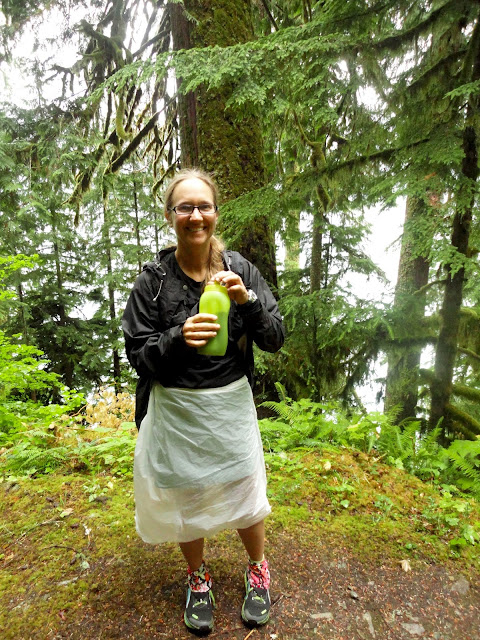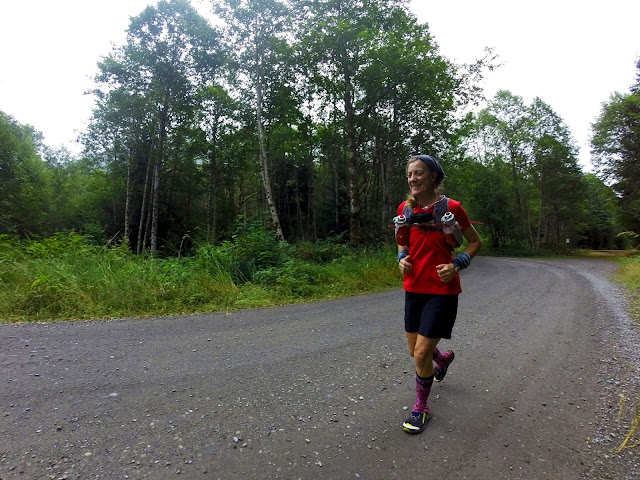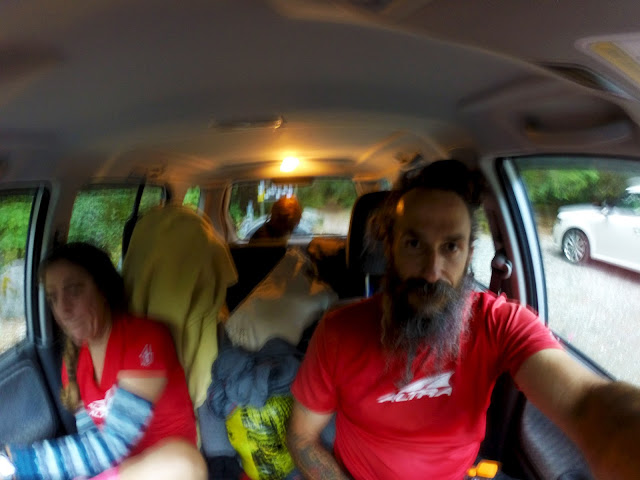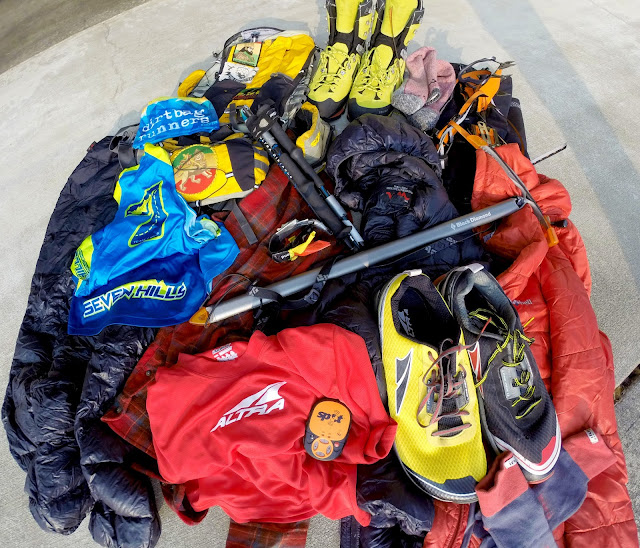If any one trail can be credited with making me who and what I am today, the Wonderland Trail is it. Sixteen years ago, the first time I hiked the Wonderland with Kathy and our daughter Angela, who was seven years old at the time, it took us 21 days to complete the 93 mile loop, including two zero days. My fastest time for the complete Wonderland is 33 hours and 35 minutes, which stands in my mind as the best running performance of my career. Despite having completed the trail ten times, I still find myself drawn to it, wanting to do it yet again; and when I am pondering potential future adventures my mind always wanders back to the Wonderland and the iconic mountain it encircles. (Read about my history with the Wonderland Trail here: Part One Part Two Part Three)
Mount Rainier haunts western Washington like a temperamental deity, at times peaking out from behind the clouds with which it obscures itself, and on other occasions boldly displaying its immensity against a deep blue sky, but always there, seen or unseen, but ever seeing. The Mountain draws tens of thousand of us puny humans to itself every year to scamper around its flanks or even, audaciously, climb its face. The vast majority of those humans return home safely, their lives enriched, their bodies and minds challenged and toughened. But every so often the Mountain kills, seemingly randomly choosing one of the animate to make inanimate, as if to say, "Remember with whom you're dealing." It's not a tame mountain.
Rainier maintains an even greater sway over me than it seems to others. Vaughan family tradition holds that in the 1930's, the days of hobnailed boots and hemp rope, my grandfather climbed Rainier. That's all my mother knows, the fact of the accomplished climb. My father passed away in 2003, and I never learned more before he left this world, as to what route my grandfather took up the Mountain, how many people he climbed with, or any of the other specifics that would add some concrete detail to the tale. It has simply been passed down that long ago a Vaughan climbed Mount Rainier. And that seed grew the idea in my mind that one day another Vaughan would climb Mount Rainier.
 |
| Prussik training the day before our adventure began. |
In my frequent meditations on my favorite Mountain I find myself constantly scheming on combinations or iterations of routes near, on, and around Rainier. Like a rat focused on finding the solution to a maze in order to obtain the cheese at the end, my mind is forever imagining routes, trail linkages, and methodologies to combine into the perfect and complete experience of the peak once widely known as Tahoma, Tacobeh, Pooskaus, Tacoma, and other appellations. Including the summit in a route seemed like the next logical step, but it also was taking things to the next level: in particular, entering the realm of mountaineering.
I'm a top notch Armchair Alpinist, but prior to this trip I had no actual mountaineering experience. I had spent plenty of time above the treeline, had lots of experience hiking on snow, and knew the basics of self arrest with an ice ax. I also had lots of real life experience that would translate. I had worked as a merchant marine and was familiar with handling rope lines and tying various knots and hitches, plus I had done high work on ships, hanging from a boatswain's chair 40 feet off the deck painting the superstructure. I had also done lots of high work as a carpenter balancing on ladders and scaling scaffolding wearing a 20 lb tool belt, as well as dancing along rooftops. But I had no proper mountaineering experience.
At some point my brain settled on the idea of combining a traverse of the summit with the Wonderland Trail, ideally doing it all unsupported, and there was no getting around the fact that I would need help. I needed the help of an experienced mountaineer who was not only an ultrarunner as well, but one mental enough to see the appeal of carrying all of our gear, food, and supplies for the entire trip, with no resupply and no dropping off trash. There was one man who came immediately to mind.
 |
| After four years as an Army Engineer at Joint Base Lewis McChord, Richard Kresser chose to make the Pacific Northwest his home permanently. Mount Rainier has always been a driving force in his life, since he first climbed it in 2007. A climber first and a trail runner second, Richard is fascinated by all mountain travel, and the most effective movement over varied terrain. In 2013, he set the Unsupported Fastest Known Time of the Wonderland Loop in 27:16. He currently works as a Race Director for Evergreen Trail Runs and the Bigfoot/Tahoe 200 Mile Endurance Races, and works ski patrol at Stevens Pass Resort in the winter. He runs for Altra Footwear and Nuun. |
Richard Kresser is a mountaineer and ultrarunner and Altra AmBadAssador that I had met and spoken with at the Cascade Crest 100 Miler in the summer of 2014. Kathy and I had captained an aide station and Richard had run the race finishing in under 22 hours for 11 place overall. He also held the Unsupported Fastest Known Time for the Wonderland Trail. At that time he told me about an ambitious project he has in the works that combines mountaineering and ultrarunning. I again ran into Richard at the Tahoe 200 Miler last September, where he was involved in putting on the race. From these facts and our conversations a gestalt arose, proving that Richard as a whole was greater than the simple sum of his parts, and that he was the man for the job.
The lodge that Kathy and I had been caretaking for the past seven years in the Okanogan Highlands had been put on the market, and had become an unlivable parade of realtors and prospective buyers. In our everyday life we are very private people, and having strangers constantly paraded through our home was horribly stressful for both of us. So we found ourselves with no fixed address. On top of that, the usual offers of and opportunities for spring work seemed to have suddenly dried up after thirteen years. I can be a challenging person to deal with on a daily basis, and it's possible that my reputation had outgrown the local job market. Additionally, grants we had applied for and proposals we had submitted to potential sponsors to fund our adventure season had not come through, leaving us very much in the lurch in every aspect of our lives.
Knowing we would be relocating to the Wetside for a while to earn an adventure budget, and wanting to keep my adventure goals moving forward, I contacted Richard by Facebook message the beginning of May 2015 with the basic idea for the Rainier Wonder Route: a concept route that would include the entire 93 mile Wonderland Trail and a traverse of the summit part way through, climbing the Disappointment Cleaver Route and descending the Emmons Glacier, carrying all of our gear and food from beginning to end. It was a crazy idea, with some clunky aspects to it, but with an unsupported "purity" that really resonated for me and, I hoped, would for Richard. I admitted to Richard that carrying our mountaineering gear for an additional 60+ miles after the traverse was kind of an "out there" idea, but that, to my way of thinking, "... Caching gear for the climb to pick up and use for the traverse and then drop before running the route out to the end just seems so ... ordinary. "
To my delight and surprise Richard Responded, "I am TOTALLY IN!"
Richard had a very tight schedule, leaving only the first half of July as a window of opportunity for the project. Moreonver, it was a particularly bad year for the climbing routes on Rainier. At the beginning of July the climbing Rangers were describing "September-like" conditions, with crevasses opening on even the highly trafficked routes, such as the D.C., and weakening and collapsing snow bridges on the Emmons. There were a number of factors against us, and we knew our chances of completing the route were slim, but we both were of a mind that it was better to try and fail than to not give it a go this year.
Between Facebook messaging and a google spreadsheet for brainstorming gear needs, Richard and I completed all of our planning for the trip online. We didn't speak on the phone or in person until Thursday, July 9, when he picked me up at the ferry landing in Mukilteo in his serial-killer-mobile, a nondescript white panel van. We had arranged to meet at 10:00 am to allow of plenty of time to get to the White River Campground early enough for Richard to teach me the essential knots and ropework for safe glacier travel as a two-man rope. From the basics of prussiking to rigging a snow anchor and z-pulley system for crevasse rescue, he demonstrated and I drilled and practised until the early evening. Then we readied our gear for the morning, and Richard went to sleep about two hours before sundown. I followed the Wonderland a couple hundred yards down to where the log bridge over the White River had been washed out, listened to boulders being clanged along the bottom by the raging chocolate milk of glacial meltwater, let my mind chew on the crossing problem, and ate a couple of Tasty Bites packets while just sitting there with the Mountain. My mind was racing with possibilities and contingency plans and my nerves were singing with the adrenaline rush of our impending adventure. Just as the sun was setting, I lay down to sleep.

At 7:55 am Friday morning Richard and I left White River Campground on the Wonderland Trail carrying 35+ pound packs containing roughly 60 hours worth of food, 40 meters of rope, boots, crampons, ice axes, helmets, down pants and jackets, gloves, harnesses and more. We covered about 200 yards before we hit the aforementioned log bridge outage. We scouted upstream a ways and found a wider braided section that was shallow and fordable on the near side of a small rock island, and on the far side had a downed log sticking over it about waist high. I had anticipated this ford and had rigged my shoes for it by removing the insoles and not wearing socks. Richard quickly removed his gaiters and socks and insoles, and then made the first crossing. The water was fast and heavy and strong and was challenging to move through even at the shallow braid. And, disconcertingly, we could hear small boulders bouncing off one another as they were hurled downstream underwater. On the second braid we were able to straddle the downed tree and hump our way across. It was precarious and ungraceful, but we were thankful to not have to deviate from the Wonderland Trail proper. Even scootching across the log the strong current reefed on our feet and lower legs, trying to topple us from our safety log and into its deadly, Quik torrent.
As soon as we were once again safely on dry ground we broke into an easy run. This is the sort of moment I live for; the entrance into insanity, the first steps in a journey to the unpossible, Sisyphus' first climb. I caught a toe on a root right away and didn't fall (I don't think Richard even knew), but hit the top of my toe hard enough to bruise it. My toe immediately went from numb with glacial runoff chill to throbbing with white hot pain. It seemed the perfect juxtaposition for the beginning of an adventure that was designed to push me to my limits and beyond, and which, with it's mountaineering aspect, was by far the most dangerous thing I had ever done. And yet we ran eagerly toward our destiny, ungainly under our packs, hovercrafts of anticipation, floating over those first four miles.

Soon after we began climbing the switchbacks up along Frying Pan Creek toward Summerland our shoes had dried a bit, so we stopped to re-rig our footwear and fill water bottles. There was a lot of water over the next number of miles, so we were just carrying one full bottle each. We took off our shoes, banged the glacial silt out of them, reinserted the insoles, put our socks back on, and got moving again. Our "fording rig" had performed admirably, and is a technique I will definitely use in the future. My shoes felt great, and with dry socks and insoles only seemed a bit damp, and perfectly comfortable.

I felt good with my poles out just clicking and climbing away. I don't know what the reality was, but at this point I felt like Richard and I were well paired, and that we were moving at a pace that was efficient for both of us. Unfortunately, this is because I was fresh and performing the best I would of the entire trip, whereas Richard had a sour stomach that had been bothering him since breakfast. Fortunately for Richard, his stomach would soon clear up. Unfortunately for both of us, my performance would deteriorate from Panhandle Gap on out.
But, blessedly, I didn't know that at the time. I was feeling good, enjoying the brisk climb on one of my very favorite trails on the planet. On any given day, if asked were I would prefer to be spending my time, I would answer, "Mount Rainier." Out on the trail, in general, is where I most feel alive, most natural, most free to be myself, most like I actually fit in somewhere. The Wonderland Trail in particular is where I feel absolutely at home and most essentially alive. Beauty was all around me and passing through me, and it passed no judgement on my ugliness, internal or external. Mount Rainier is not were I feel closest to God, but where I feel most overwhelmed by God.
I know for a fact that God is not an angry bearded caucasian man in the sky causing wealthy first-worlders minor inconveniences as cosmic payback for their manifold sins and wickedness, or influencing the outcome of reality teevee shows in response to frantic and plaintiff mutterings of, "Oh, PleaseJesusPleaseJesusPleaseJesusPleaseLetUsWinThis!" I'm less convinced that God might not be a mountain. But I'll stop short of asserting that, and will say that Mount Rainier is a Divine Wi-fi Hotspot. To interpolate this in terms of hebrew numerology, Rainier is a 7g network; a perfect connection. On one of our most recent Wonderland Trail hikes, Kathy and Angela and I passed a woman climbing up from Indian Bar as we were heading down to it from Panhandle Gap. She was wearing foam gardening kneepads, and we had seen her kneeling down on the trail with her face nearly in the dirt. It's possible that she was a botanist or an entomologist studying something so small we hadn't noticed it. But she wasn't wearing a National Park uniform and didn't have the federal government vibe many NPS employees unwittingly emit. My impression was, and still is, that she was doing prostrations, one on each of the erosion steps. A little research shows this was likely A K Mimi Allin. I presume one of the reasons she chose Rainier is because the cosmic reception is so good.
 |
As we were making our way up along Frying Pan Creek, just below Summerland, we met Jerry and Mary Zyskowski. As Richard and I came up behind them, I saw their packs were festooned with patches commemorating treks and adventures all over the world. We chatted briefly as we passed them, and then again outside Summerland when they passed us. I asked Mary if I could take her photo, but she said she was uncomfortable with that, but she was okay with us taking a photo from the back to show some of her patches. I'm flattering myself, but I felt a kinship with these two Hominids, as if my soul recognized kindred spirits, and I felt some regret that we were at the beginning of a fast push and couldn't stop to hear some of their stories. I hope Jerry and Mary are a glimpse of what the future holds for Kathy and I. In other words, when I grow up, I wanna be like Mary and Jerry Zyskowski.
|

My pack felt about as heavy as on the Unsupported Washington Traverse last year, so I guestimate it was nearly 40 pounds; perhaps a couple pounds over that if you include 4 1/2 pounds of climbing rope. The weight was noticeable, but felt like I could sustain a good pace while carrying it. The day was cloudy, which was a blessing, as daytime temperatures had been scorching hot for weeks. As we climbed past Summerland and up toward Panhandle Gap I was still feeling strong, but Richard was getting over his stomach problems and starting to outpace me. I would turn a corner thinking I was right behind him, only to find him 100 yards up the trail. From this point on I could never keep up with him, much to my chagrin.

Surprisingly, there was no snow at all on Panhandle Gap, or on the traverse above Indian Bar. This was vexing in the middle of July. Most years it's all snow hiking from below Panhandle Gap all the way across the top of Ohanapecosh Park to the beginning of the descent toward Indian Bar until the middle of August. When we bought our climbing permit the ranger inundated us with pessimistic route beta, especially for the Emmons. She referred to "September-like" conditions, and that certainly applied to Panhandle Gap. I can't recall ever before moving through that section without touching snow at all. I knew this would mean few water sources along the Cowlitz Divide, if any. But over the gap and across and down to Indian Bar water would be not only plentiful, but delicious; some of the best tasting water I've had in my life, ice cold, fresh off the Fryingpan Glacier.
 |
| A disturbingly snow-free Panhandle Gap. |
We started running again as we dropped over the rim of Panhandle Gap, just as the sun came out from behind the clouds, and the temperature jumped twenty degrees. We slaked our thirst at many of the creek crossings as we whoopdeedooed our way along the top of Ohanapecosh Park, alternating between gentle runable downhills and short climbs. In the heat of the direct sun I was much more aware of the weight of my pack. I could feel that my entire core was working hard to stabilize me while running under the weight of my load. The heat was magnifying the effect.
As we began the descent to Indian Bar my discomfort continued to increase and my performance continued to decline. The steep downhill on the erosion steps was battering me and sapping my energy. When we hit the valley floor and neared the Indian Bar camp I had just about caught up with Richard again. I told him I needed a short sit down break. It seemed we were both feeling the heat, but me moreso. I was out of breath and dripping sweat. Although we found a shady spot just across the bridge from the camp, the air was stagnant, with no cooling breeze, and the pause did not refresh as much as I had hoped.
The sun was still out in full, and the direct strength of it felt as though it were causing my skin to sizzle. From Indian Bar across the Cowlitz Divide is often very exposed and hot. Most of the times I've moved through this section of trail, it's been in short bursts of hiking or running from one patch of shade to the next. Today would be no different, except that usually there would be snow to eat and hold on my neck to cool myself, as well as seasonal snowmelt runoff, cold and refreshing. This year there was none of that. There was no water from Indian Bar to Nickel Creek. We had filled our bottles from the creek by the Indian Bar Group Site shelter, but at the rate I was sweating, that would leave me without water well before Nickel Creek.
I was moving efficiently on the flats and downhills. Climbs were a different matter. There have been lots of times that I have performed well in warm weather for days or weeks on end, but this was not one of those times. On even the slighest uphill gradient I slowed to a crawl. Barely into the double digits mileage wise, I was already to the point of having to force myself to take 100 steps before allowing myself to lean on my poles and rest for a minute. Whether I still wasn't fully recovered from the Pigtails 200 Miler over Memorial Day, or was suffering the deleterious effects of living at sea level for the past six weeks after living and training at 3500 feet and higher for the last fourteen years, I know not. My performance was atrocious, that I do know, and in my mind's eye I could see all of our plans unraveling.
The mountaineering portion of this project was predicated on the idea of hitting Camp Muir between 10:00 pm and midnight. That would allow us to push on for the summit during the cold of night, when rockfall would be minimized, top out at dawn, then have the morning light to sight out our line down the Emmons in the cool of the morning while the snow bridges were still solid.
I became more and more convinced I was suffering a minor case of heat stroke. Each time I would sit down on the side of the trail for a minutes to allow my core temperature to tick down a notch or two, my mind would be running numbers, trying to figure out what pace I would have to make for the rest of the way up to Camp Muir in order to hit our dawn summit goal. This produced an anxiety that I am unused to in my adventuring. Usually my timelines are based solely on my goals and aspirations, and I don't worry too much about backing off from an A goal in order to hit goals B, C, and D. But on this project the effects would cascade through our entire timeline, and we didn't have days of leeway with which to play.
I pushed on, constantly telling myself that if I ate and drank a little more, I would feel better, that there was plenty of time to salvage this effort and turn things around. We finally made it over the last of the spires along the Cowlitz and began the extended descent to Nickle Creek. Back on flats and downhills I was moving well again, if not quite keeping up with Richard. After a few miles of pleasant, duffy single track, I caught up to Richard at Nickle Creek, where we both ate and drank and filled our bottles as we rested and cooled down. Richard was clearly feeling better than I was, and he took over carrying the 40 meter rope at that point.

Cloud cover closed in and once again the temperature dropped. This was an immense help, but did not restore me as much as I had hoped. The cool felt good, but there was also increasing moisture in the air. We moved well over a few miles past box canyon and down to Maple Creek. Then we turned uphill to begin our 12,000+ foot climb to the summit, and I immediately once again slowed.
I can't say enough about how patient Richard was with my performance in this section. Each time we would sit for a couple of moments I would vow to keep up with him from then on. But once we started moving, my motivation would flag and my breathing would run away from me. I would stop and catch my breath and feel revivified, then be panting and brought up short again by my lack of wind. I cycled through this over and over, continuing to grind away not only at the climb, but at our dwindling time budget. In essence, I was writing checks my watch couldn't cover.
On top of all that, I had very little appetite. I had to invest in some gear for this trip on shorter notice than I would have liked, plus we had just relocated from the east side of the mountains and had only just paid off those costs. I was super broke coming into this adventure, and the one place I ended up being able to cut corners budget-wise was food. I had two big boxes of old school crunchy granola bars, a jar of chocolate hazelnut butter, a few packets of ramen, a few pouches of Tasty Bites, and a large baggie of oreos. Many of these things I had on hand, and that's what I had with which to make do. These were all foods I had successfully fueled with for thru-hikes and adventure runs in the past, but now they were failing me. They were unappealing and difficult to eat. I kept forcing spoonfuls of nutbutter into my mouth and washing them down with water, like big slimey pills. Same thing with the oreos. I would cram a few into my mouth and begin to chew them, then add water and chew it into a slurry I could swallow, then chase it with more water. But no matter which calories I took in or how often, I never seemed to get a boost of energy or any uptick in performance. I was fueling the grind, but just barely.
As we were climbing up to Reflection Lakes, where we would leave the Wonderland and make for Paradise, the weather turned more grey, and more wet, and more drippy. We found ourselves surrounded by thick, vaporous fog, and the underbrush began to paint us moistly as we passed. Then I felt a twang in my right quadriceps. There was now pain with each step, and when I came to a stop, I could see a muscle in the middle of my thigh spasming. Messaging it and stretching it during stops and paying careful attention to pointing my toe straight forward with each step had the cumulative effect of easing the pain, but not completely eliminating it. My mind was on the verge of panic, reeling, wondering pessimistically, "What else could go wrong?" But I kept reigning my worries in with a focus on form, breathing, and eating; the most essential basics of a Biped.
I feel like I was drifting in and out of consciousness for the rest of the climb up to Paradise. I remember at one point Richard and I both stopped and sat down on the side of the trail and fell asleep for fifteen minutes or so. Much of the climb is unclear from any dreams I may have had during that nap. There's no way to tell where one ended and the other began. I had never touched any of these trails off the Wonderland proper, and I had never even been to Paradise before, but that failed to excite me or hold my attention. I was stumbling through a swirling mist of vapor toward an unseen goal an unknowable distance away, or so it seemed. There was as much fog inside my head as out.
Each time I caught up to Richard he seemed to give us dwindling odds of achieving even a small portion of our goals. The Wonder Route seemed like a mathematical impossibility, the traverse seemed very unlikely to go, and even a simple summit attempt might be out of the question. I had no choice but to listen to Richard and accept what he was saying. He had the mountaineering experience and I was in complete agreement that he would have the final word on decision in his bailiwick. I could urge patience and restraint from making decision before they needed to be made, but I would accept his dictates when it came down to it. But for now there were still possibilities, so we kept climbing.
When we reached Paradise I needed to get out of the dang dripping mist, eat a bit, put on my rain shell, and reorganize my pack. We dismissed the idea of entering the crowded lodge, and instead spread ourselves out on the floor of the entryway to the closed Climber's Center. A few employees came and went as we dirtied up the floor, but there were all friendly and interested in what we were up to. Telling our plan to a few of them and seeing their eyes widen at the audacity of it seemed to renew our conviction. Regardless of how bad our odds of success might be, we had not yet come nearly far enough to turn back. There was only one way to go: onward and upward.
Richard shared some Airheads and Sourpatch Kids candies that tasted great to me, and I finally began to feel some energy returning. We got out our headlamps, layered up, and began the climb up to Camp Muir four hours after our intended departure time.
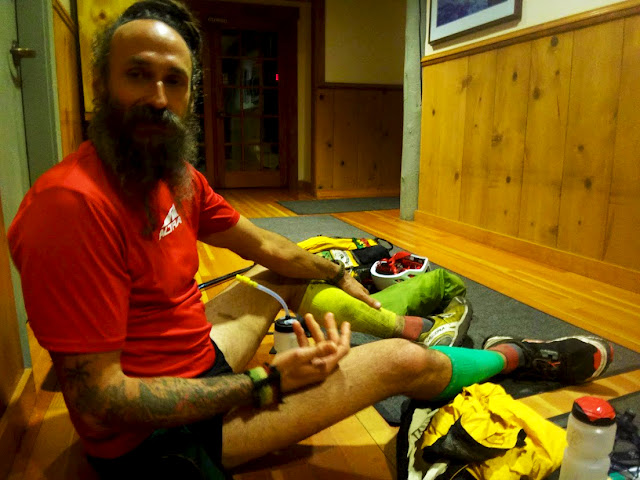 |
| Muddying up the vestibule of the Climber's Center. Brother, can ya spare a Sourpatch Kid? |
Almost immediately upon leaving Paradise we saw two Cascade Foxes. There were fairly aggressively begging for food, and it seemed obvious that they were used to be given that for which they asked. We didn't feed them, and before long they pushed past us and continued on their way down to paradise.
Finally, the foggy mist turned into clear, open air as we climbed above the weather. The asphalt path turned to trail and stacked rock staircases, then eventually turned into the Muir Snowfield. It was finally time to switch into boots and get the heaviest items in our packs off of our backs and onto our feet. I tucked my beloved Lone Peaks away in my pack and put on my down pants and the heavy mountaineering boots I had been carrying for the last 30 miles. It was the first time I had worn a stiff, traditional boot in fifteen years or so. I had switched to hiking in running shoes years before I even started running, so this was an uncomfortable step backwards in my evolution as a Biped. But at this point, I was happy enough to have them out of my pack that I didn't mind them being on my feet.
We got moving again. We had climbed about 8,000 feet since Maple Creek, and had another 2,000 to go to reach Camp Muir. I would force myself to take 500 steps before allowing myself a three minute sit break. The breaks were self-limiting because of the cold, which was a good thing. While climbing I would warm up and then pull the legs of my puffy pants up above my knees like shorts to allow for ventilation. During breaks, I would cover up my legs to retain warmth. Once I felt the first touch of a chill, I would start climbing again. It was a tedious cycle, but a productive one. And the quiet and dark and solitude on the Muir Snowfield in the wee hours of the morning was wonderous.
Richard and I stumped into Camp Muir at 4:00 am and sat down outside the shelter to layer up and discuss our remaining possibilities. At this point, making an immediate push, Richard was giving us almost no chance at the traverse. He rated the summit going both up and down the Disappointment Cleaver Route as a 50-50 shot. So, in other words, we may have just covered 30+ miles by foot carrying a ridiculous amount of gear to no end. My brain couldn't fathom that. my brain was processing the logistics as quickly as it could, clicking and whirring like a 1960's mainframe computer, frantically struggling to spit out a punch card with a significant series of holes in it.
I proposed to Richard that we just hang out at Camp Muir and sleep and eat and rest the entire time until 10:00 pm the following night, the ideal departure time upon which we had planned, albeit twenty four hours later. It would take the Rainier Wonder Route off the table because of Richards schedule and the impact it would have on my food stores. But it would make the summit a very solid possibility, and would keep the traverse on the table as a heavily weighted maybe. If we could make the traverse go, we realized we could still salvage a rather stout and elegant unsupported project out of the ruins of our Wonder Route plans. Richard agreed, and we both put on our puffy gear and racked out in the shelter, as neither of us was carrying a sleeping bag or bivy or tent.
The next day was one of anxiety like I've never felt during an adventure. Nothing was a given, and very little of it was within my control. As I tried to sleep and rest and relax, my mind played out worst-case scenario after worst-case scenario. And by worst-case scenario, I don't mean a crevasse fall, I mean failure; failure to follow in my grandfather's footsteps; failure to meet the goals I had so publicly put forward; failure to properly prepare myself for this challenge; and failure to test the limits of my physical and mental strength due to time limitations and weather imperfections. These thoughts seemed to gnaw at the fringes of my sanity throughout that day, and no matter how vigorously I shooed the worry birds away, then returned to find room to roost as soon as my attention was focused elsewhere.
It turned out Tanya Hoffman was as Camp Muir that same day. A group she was leading of three three-person ropes had summited that morning and were riding the adrenaline high of their accomplishment. The excitement was contagious and helped to buoy my confidence.
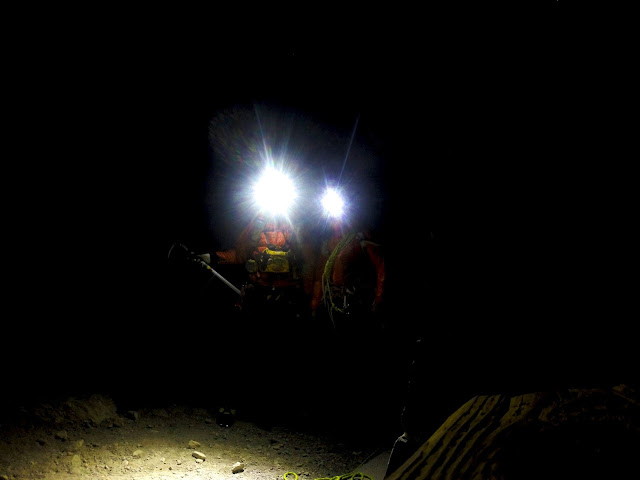
We put on crampons, harnesses, helmets and headlamps and roped up, beginning our climb a little after 10:00 pm, just as proper dark fell. The Disappointment Cleaver Route is maintained by the guide services that take paying clients up and down it almost daily, and when there is no fresh snowfall to contend with, climbing it is simply a matter of following the trail. Heather "Anish" Anderson, who had summited a couple of days earlier told me afterwards, "Yeah, the boot path up the mountain really made me feel like I was walking on a shoveled sidewalk in a mid-west winter (except for the crevasses!)"
The crevasses were bridged with aluminum ladders with planks secured across them. In the dark they were easy to cross, because there was no perception of exposure or distance or depth. The planks were illuminated by my headlamp, and everything else simply faded off into darkness, as though the only things that were real in the universe were those few things illuminated by my headlamp. My crampons bit into the planks nicely, and there were handlines fixed to hold onto. This infrastructure was in place and there was no point in trying to not use it. Indeed, in all but one instance there really was no way NOT to use the ladders. The exception was a ladder rigged on an uphill slope at an awkward angle that I found easier to climb beside than actually walk over.

The climb up the D.C. Route was difficult, in that it took some effort, but it was easy in that it was non-technical. It really was just hiking uphill in the snow very slowly. If I tried to push the pace at all I would break out in a sweat as well as outpace my breathing, and before long I would have to stop and catch my breath and cool down. I eventually slowed to a dirgelike waltz wherein I took one full breath in and out to each step and ice ax placement. Step, breathe in, breathe out. Step again, breathe in, breathe out. Move ax forward, breathe in, breathe out. Repeat. Going at this pace, with my puffy pants pulled up over my knees and my puffy coat sleeves slid up over my elbows, I could keep moving for extended periods in between breaks.
Richard and I ground away at the climb until dawn overtook us. Then we turned off our headlamps and kept climbing. Eventually we made it to the summit crater and only had a few hundred more feet to climb to the summit proper. I had made the entire climb thus far in puffy down pants, my Altra tech shirt, a synthetic puffy jacket, and a bandito (buff, or neck gaiter). I added my Pendleton wool shirt to my layers when we stopped to melt snow for water and to answer one of the final questions standing in our way: would we be able to make enough water? Because of our extra day at Camp Muir, we had burned through more stove fuel than anticipated. When we began our climb, we each had about 1 1/2 liters of water, and not much of an idea how much fuel was left in the canister. We had been offered water at the camp, but we had talked it through and had agreed to adhere to our unsupported ethic of only taking water from natural sources. In the end, we were able to make another 1 1/2 liter apiece, enough to get us far enough down the Emmons Route to get to liquid water. Our water would go, soon we would find out if the route would.
 |
| Celebratory Summit Shenanigans. (l-r: Vaughan, Kresser) |
The summit was socked in by fog, so there were no stunning views, no open vistas, no perspective of height. But that's okay with me. My adventures are very much an internal experience to a great degree, and the summit I was standing on in my mind had a clarity that the physical one lacked. We set the camera up on a timer and took some summit shots for fun and posterity. Including Heather a couple of days before, three Altra AmBadAssadors had stood on the summit of Mount Rainier within a 48 hour period. Not bad for a running shoe company.
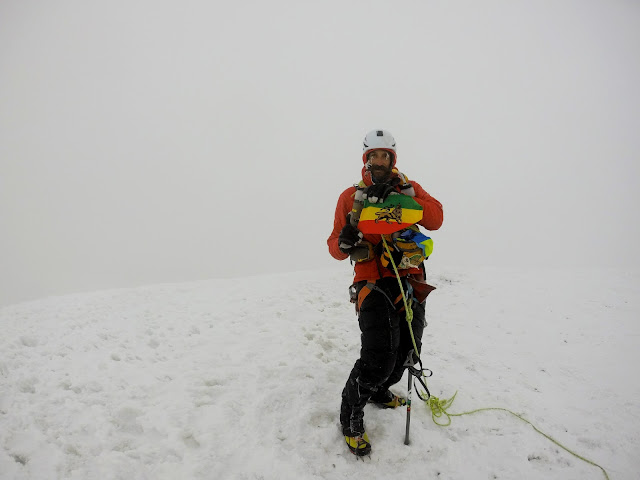 |
| Living Rastafari informs every aspect of who and what I am, and I was proud to stand on the highest point in the lower 48 US states as a Rastaman. As much as Mount Rainier is a giant antennae, this was a unique opportunity to broadcast some positive vibes around the world. |
 |
| One of Kathy's Trail Totems frost rimed on the summit of Mount Rainier. |
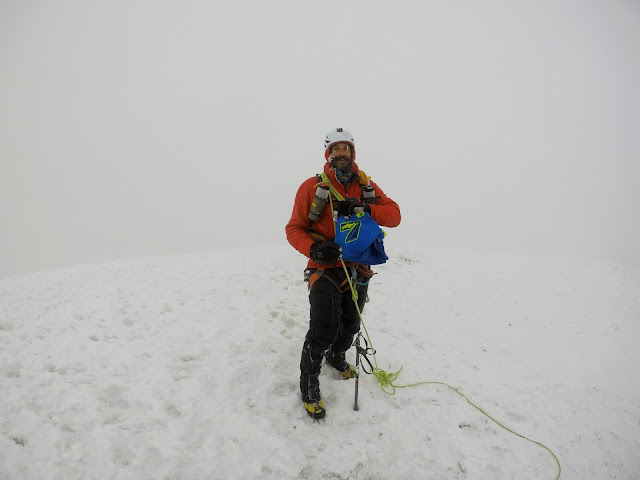 |
| Seven Hills Running Shop has a unique vision for its team and the running culture that they promote. The shop is represented by innovative adventurers, climbers, and thru-hikers as much as it is speedy runners, and I'm proud to be a part of such a unique collection of Hominids. |

After making the summit, all we had left was the question of the Emmons Glacier Route. When Richard checked in at the Climbing Ranger station at Camp Muir he was again met with pessimistic route beta, and I knew that he still thought there was a good chance it wouldn't go. Richard had only been part way up the Emmons before, and had been sidetracked when his group came upon a rope team that had taken a crevasse fall, landed on a narrow ledge, and had overnighted in the crevasse. After calling for help via cellphone and waiting for it to arrive, Richard's party had descended once again to Camp Sherman and given up their summit bid. So Richard had never been on the top end of the route and wasn't familiar with it.
When we were melting snow we agreed that we would give it a shot, and that worst-case scenario, we would have to climb back up and descend by the D.C. But almost as soon as we started down the Emmons Glacier Route we saw three ropes of climbers heading up toward us. We talked to the front rope and they assured us that the route was fine. Not only was there a clear route through the crevasses and the snow bridges were solid and safe, but they had made a boot track we could follow, had wanded the route, and had set pickets for protection on the sketchiest snow bridges.
Richard was stoked to finally get some optimistic route beta, but he was still feeling the pressure of leading a novice (me) on this route, so he wanted to keep moving and make it over the sketchiest of the snow bridges before the day warmed up, so we were immediately off. I was moving much better on the descent than I had been on the ascent by a long shot, so we made good, consistent progress. after we had dropped down a couple thousand feet the fog and cloud lifted and absolutely stunning views surrounded us.

The more the sky cleared, the more beauty was revealed surrounding us. We were immersed in frozen visions of violent upheavals, the ghostly glacial blue in the depths of crevasses, the deep dark blue of the high altitude sky, and the brown-stippled white of snow with bare rock protruding through it. It was an amazing place to move through, a beautiful and moving place of movement. So move we did. As much as we had moved relentlessly up the previous day and evening and morning, the remainder of this miniature eternity would be spent in descent.

My emotions lifted and my spirit soared as the realization finally began to dawn on me that I had stood on the summit of the same mountain upon which my paternal grandfather had previously stood. Pa, as I called him, had passed away when I was still a boy, and I only remember meeting him a few times. One of those times he had bitten me on the nose, although in retrospect I suspect it was meant to be playful and was more of a gumming than an actual bite. But that's one of the few memories I have of him. And now we share The Mountain, and it's one of the few experiences I have to connect me to him.

Not only that, but our traverse was going. The Rainier Wonder Route would not be completed, not by us, not this day or the next. But we were putting up a nice test piece for anyone who wants to hurl themselves at the mountain an unnecessarily difficult way. The further we descended the more sure a thing this became. And when Camp Sherman came into view and we could sight out the route all the way down, the time for reserving our elation came to an end. We no longer had to reign in our hopes, but could accept that we had achieved a major accomplishment, blurring the lines between mountaineering and adventure running, while only catching a fleeting glimpse of our own limits.

As we descended the day was warming up considerably. I had stopped up high to take off my wool shirt, no longer needing it. By about the halfway point I had stopped again to remove my gloves and puffy jacket, and I had my down pants pulled up above my knees for ventilation. The heat had held off just long enough for us to make it past the most dangerous of the snow bridges. I could sense Richard relaxing as the question marks of our project were resolved, and as the burden of his responsibility for his own well being and mine was lifted from his shoulders.

When we hit Camp Sherman we were both sweating in the warmth of the day. Even though cloud cover had rolled back in, the effort of moving in soft snow wearing heavy climbing boots and crampons was warming us from the inside faster than we could cool. We both traded our puffy pants for running shorts and an odd hybrid kit of ultrarunner meets mountaineer: short sleeve tech shirt, glacier glasses, helmet, ice ax, harness, boots and crampons. We would continue to travel roped up down the Inter Glacier until we reached Glacier Basin, as there was still the potential for crevasse falls, albeit slight.

From Camp Sherman on down the mood was triumphant, light-hearted, and even playful. We ran down the soft steepness of the Inter Glacier, plunging down in big, heavy-footed strides like video footage of astronauts walking on the moon played at high-speed fast forward. We dropped to our butts and glissaded seated for hundreds and hundreds of feet. It struck me that there was an odd, and perhaps childish, symmetry to this: at the beginning of our trip the White River had forced us to drag our asses across a log to begin our journey, and now we were ending it by dragging our asses across the very headwaters of the White River itself. Poetic? Perhaps not. But at that point I was more than willing to accept whimsy in place of poesy.

When finally we reached the end of the Inter Glacier and switched out our climbing boots for trail running shoes once again, we knew we had reached the completion of the circle in every sense. In our burdened and ungainly manner we trotted out the last few miles to the White River Campground. As often happens at the conclusion of epic adventures, we passed scores of dayhikers, car campers, and tourists, none of whom suspected what we had just done. To a degree it was already becoming a secret thing, an experience that, no matter how much we talked about it, no one could truly grasp without setting foot to trail and actually doing it.
In the end, including roughly 18 hours spent doing nothing at Camp Muir, it took us 54 hours and 32 minutes to establish the Only Known Time for what I am calling the Cowlitz Connection Route. Comprising some 50 miles and 17,000 feet of elevation gain the Cowlitz Connection is a solid undertaking. But, as I've said before, an Only Known Time is the Schroedinger's Cat of FKTs. It exists simultaneously as both the Fastest and Slowest Known Time for a route, and our time is decidedly at the slow end of the spectrum. Had we not had our sights set on an even grander endeavor, had we set out specifically and only to do the Cowlitz Connection we could easily have taken twelve hours off our time. But it is what it is, and I'm extremely stoked that we were able to overcome so many challenges and stumbling blocks and accomplish what we did.
My heartfelt thanks goes out especially to Richard Kresser for taking a big risk on the crazy idea of an inexperienced fledgling mountaineer. I look forward to attempting another adventure together that's at least as ridiculous in scope and ambitious in intent as this one was.
And for all that, the Rainier Wonder Route is still on the table. I don't know when or if I'll attempt it again. I have another idea for a unique double circumambulation of the Mountain that I need to start researching. Plus there's Chad Kellogg's Infinity Loop Route, of which I only learned recently. It's above my skill level at the moment for sure, but I know my brain is going to have trouble letting go of that idea anytime soon. And, in the end, for me, that's what it's all about. The mental mastication, ingestion, and metabolism of an idea that leads to the eventual excretion of the adventure itself. And if you followed my metaphor closely you'll notice the previous sentence ended with both a period and a colon.
What a Blessing to be a Hominid! Give Thanks for Life!
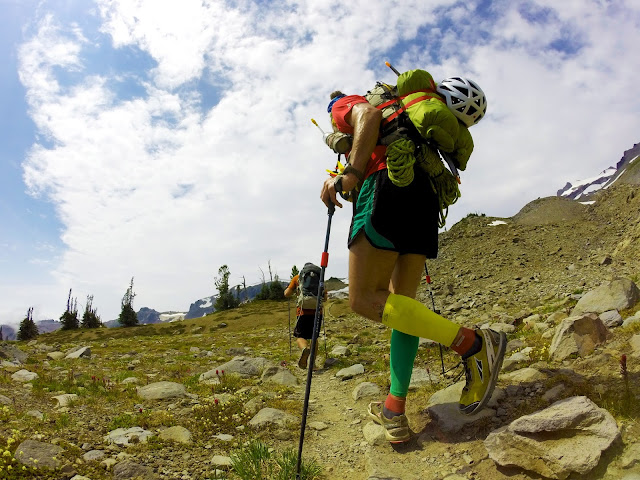
Gear List:Altra Lone Peak 2.0 trailrunning shoes
Zensah Calf Sleeves
Western Mountaineering puffy down pants
Western Mountaineering puffy down jacket (didn't use)
Montbell synthetic puffy jacket
Pendleton button-up long sleeve wool shirt
Darn Tough hiking socks, 1 pair
Injinji Trail 2.0 Midweight Mini-crew toesocks, one pair
North Face gore-tex shell
Black Diamond Gloves
Black Diamond Ice Ax
Black Diamond Polar Icon Headlamp
Black Diamond Ultradistance z-poles
Black Diamond Coulior Climbing Harness
3 locking carabiners, 3 standard carabiners, 2 slings, 2 prussiks, 1 pulley
Outdoor Research Gaiters
Petzl Crampons
WAA UltraBag Pack with two 1 liter bottles
Salewa Boots
Julbo glacier glasses
Altra tech shirt
Team 7 Hills jersey (didn't wear)
REI merino wool glove liners (didn't wear)
Dirtbag Runners bandito
Fleece camo hat
Fleece UltraPedestrian hat
2xU running shorts
Platypus Unbottle 2 Liter
Pendleton Wool Shirt
REI ultralight 10 liter Drysack, two
webbing strap with buckle for attaching drybags to pack, two
SPOT Transponder
Sony Walkman mp3 player
Asio Altimeter watch
pre-charged portable charger
6' duct tape wrapped around each trekking pole, 12' total




